Create successful ePaper yourself
Turn your PDF publications into a flip-book with our unique Google optimized e-Paper software.
The company’s TG2300-B tower gantry cranes are<br />
leased to Falcon Steel Corporation, a Delaware<br />
company in charge of fabricating and erecting<br />
the steel structure. Each TG2300-B crane has a<br />
minimum 230-ton lifting capacity and a maximum<br />
boom length of 240 feet. The cranes employ<br />
a modular design so they can be modified for<br />
individual project needs. As a building grows in<br />
height, the crane can grow, too—by hoisting and<br />
stacking an additional tower structure on itself.<br />
Improvements all around<br />
After the first test engine was installed, Garrahan<br />
said there were immediate improvements in<br />
performance, noise, exhaust emissions and fuel<br />
efficiency. “In today’s world you need a today<br />
engine and we found the Tier 3 Series 60 to<br />
be that. We maintained the power and muscle<br />
requirements to do the work, and also increased<br />
the fuel efficiency—we’ve almost cut it in half. On<br />
this job with three cranes, that’s a fuel savings<br />
of approximately $500 per day or upwards of<br />
$90,000 to $100,000 annually,” he said.<br />
Engine noise was also a concern—especially since<br />
these cranes operate for eight or more hours a<br />
day in densely populated Manhattan. The Series<br />
«It feels good to know that we worked together to make<br />
cleaner air. And not to mention it gave them a step up on<br />
the competition. »<br />
Bob Shomo, Senior Vice President Engine Sales Johnson & Towers, Inc.<br />
60 Tier 3 engine is significantly quieter than the<br />
old Detroit Diesel 2-Cycle 12V71T engines. “This<br />
engine operates within acceptable noise levels<br />
in the city. It almost makes the crane feel brand<br />
new. It’s been a very positive experience,” says<br />
Garrahan. “You’re always trying to operate at<br />
levels below typical street noise, or less, so that<br />
people don’t notice it. These engines do that.”<br />
A huge commitment<br />
Repowering three cranes was one thing, but<br />
repowering a whole fleet of 18 cranes was quite<br />
another in terms of investment by Cornell &<br />
Company. Because the repowering project would<br />
have a significant, positive impact on air quality at<br />
construction sites in New York and around the<br />
Northeast, Johnson & Towers decided to help<br />
Cornell & Company apply for a federal grant<br />
as part of the Diesel Emissions Reduction Act<br />
(DERA). This federal program set aside $150<br />
million to help subsidize the replacement of older<br />
diesel engines in marine, rail and industrial<br />
equipment throughout the United States. Of 251<br />
proposals submitted to DERA in 2010, Cornell &<br />
Company’s application was one of only seven in<br />
the country that were approved.<br />
The grant covered 75 percent of the cost of the<br />
new engines and paved the way for repowering<br />
Cornell & Company’s total fleet of 18 gantry tower<br />
cranes. By repowering its entire fleet, Cornell &<br />
Company expects to reduce NOx emissions by<br />
30 tons/year and particulate matter by 1.5 tons/<br />
year. Shomo says, “Cornell & Company is the<br />
only crane fleet in America to make this kind of<br />
environmental commitment. It feels good to know<br />
that we worked together to make cleaner air. And<br />
not to mention, it gave them a step up on the<br />
competition.”<br />
Going above and beyond<br />
The repowered cranes are currently hard at<br />
work, erecting the steel structure at 3 World<br />
Trade Center five days a week, sometimes<br />
working double shifts. The cranes can hoist<br />
steel components weighing more than 50 tons.<br />
Garrahan says, “The work is relentless. An eightto<br />
ten-hour day is expected. If it’s down, people<br />
are screaming and yelling. So reliability is key. The<br />
crane is the lifeblood of the job. It sets the pace<br />
of the entire project. Uptime is critical.”<br />
After starting the job in the fall of 2012, two of<br />
the three cranes will continue until the last beam<br />
is set in place in the winter of 2013. So far, the<br />
results are very favorable, according to Garrahan.<br />
“Every aspect of this project has been a win.<br />
I can’t say enough about how happy we are to<br />
have hooked up with Johnson & Towers and <strong>MTU</strong>.<br />
Their expertise and support have been excellent.<br />
It’s been a really good experience. Since we<br />
repowered, our clients have gone with this<br />
engine upgrade again and again. It’s been a very<br />
successful thing for us and for <strong>MTU</strong>.”<br />
In the bigger picture, there’s a sense of<br />
accomplishment that can’t be measured.<br />
Everyone at Cornell & Company is honored to<br />
work at the Manhattan site. After all, they’re not<br />
simply building a skyscraper; they’re helping to<br />
rebuild the hopes and spirits of many Americans.<br />
“We’re very proud to be affiliated with the<br />
project,” says Garrahan. “For me to get involved<br />
is a great privilege. And for Delor Cornell, it’s a<br />
bit stronger because she was across the river,<br />
on a jobsite when it happened. And now we’re<br />
restoring that piece of our country.”<br />
Words: Chuck Mahnken<br />
Pictures: Cornel Company, Fotolia, Getty<br />
Images<br />
To find out more, contact:<br />
David Combs<br />
david.combs@tognum.com<br />
Tel. +1 248 560 8182<br />
<strong>MTU</strong> Report 03/12 I 33


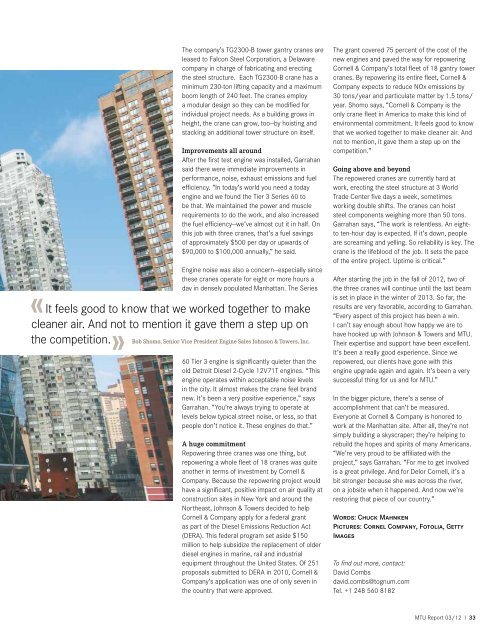



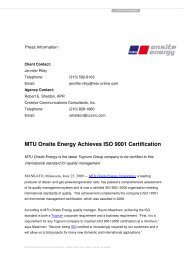

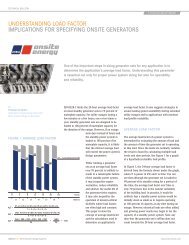


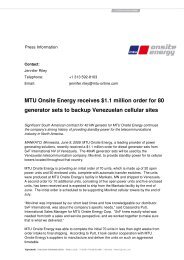

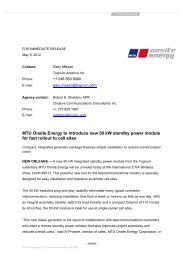

![Full power range of diesel generator sets [PDF] - MTU Onsite Energy](https://img.yumpu.com/28297693/1/190x253/full-power-range-of-diesel-generator-sets-pdf-mtu-onsite-energy.jpg?quality=85)
